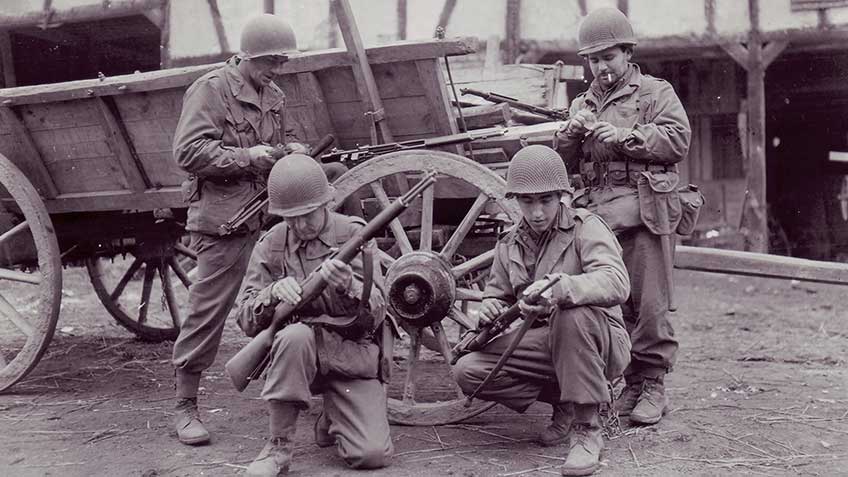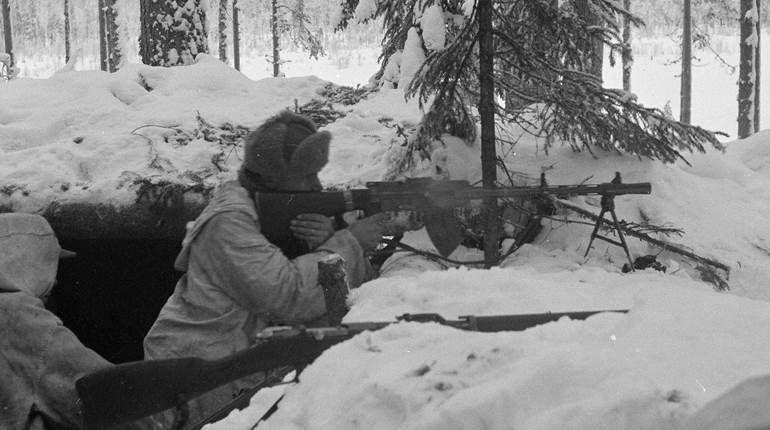On March 7th, when lead elements of the US 9th Armored Division entered the town of Remagen, the troops were quite surprised to find the Ludendorff railway bridge still standing. Despite German plans to destroy it, the 325-meter-long span remained upright, providing a potential gateway across the Rhine for American troops, and a chance for weary GIs to enter Germany without yet another amphibious operation.

The incredible value of the bridge to the American advance was plain to see, but first it had to be taken. A small group of infantrymen needed to make a furious dash across the Rhine, with their every step under fire from machine guns and snipers, and every meter of the bridge wired with explosives. Odds were given that the Germans would blow the bridge sky high before the first American could even set foot on it.
The German defenses of Remagen and the bridge in particular, were hastily assembled under the command of Captain Willi Bratge, a highly decorated combat veteran. Even if Bratge was the right man for the job, the overall German situation was terribly confused. Orders countermanded other orders. Promised reinforcements never arrived. Command-and-control appeared to be almost non-existent. For example, a Luftwaffe anti-aircraft unit had been positioned atop the “Erpeler Lay," an excellent position on a bluff atop a 600-foot cliff that overlooked Remagen town and the Ludendorff Bridge.

No one bothered to tell Captain Bratge that this veteran flak unit was transferred to defend Coblenz and was replaced by an inexperienced battery that didn’t even have motor transport. The cornerstone of the bridge defense was gone. To make matters worse, on the night of March 6th, several of the replacement flak gunners deserted, and as the Americans attacked the town, the remaining anti-aircraft crews were struggling to manhandle their guns across the bridge and onto the heights on the eastern side.
The other German defenders in the area were a hodgepodge of troops ranging from combat engineers (responsible for the explosives on the bridge), some highly unreliable Eastern Volunteers, along with Hitler Youth and more than 500 members of the local Volkssturm (“People’s Army”). The Eastern Volunteers were made up of Russian POWs working in labor battalions and later pressed into service as combat troops.

These men were of suspect loyalty and were barely equipped to be effective fighters. The Hitler Youth members were teenagers, full of enthusiasm but critically short on experience. Finally, the Volkssturm force was made up of boys to old men, ranging in age from 15 to 65. They carried a wide range of weapons, from the latest German small arms to some rifles from pre-WWI vintage. Volkssturm performance on the battlefield was erratic and unpredictable. They lacked training and cohesive leadership, but they were often passionate—they were literally fighting for their homes. Bratge’s defense needed a miracle, but there was none coming.
“What If The Bridge Blows Up In My Face?”
As the stunned Americans looked out at the bridge, packed with troops, military vehicles, along with civilian refugees with their wagons and livestock, Brigadier General Hoge made a command decision. The potential results outweighed the risks, so without any intel on what his troops were charging in to, he ordered his men to capture the bridge.
Battalion Commander Major Deevers asked Lieutenant Timmerman of the 27th Armored Infantry Battalion if he could get his men across the bridge. The young lieutenant, promoted just the night before, responded that he could try. No one knew if it was a trap, but everyone knew that the bridge was loaded with explosives and ready to blow. Deevers commanded, “Go ahead.” Timmerman asked him “What if the bridge blows up in my face?” His commander gave no reply.

By normal military standards, the Remagen Bridge was long overdue for demolition. But several factors stood in the way of good tactical sense. First there were not enough explosives available, and those that had been sent were substandard industrial-type charges normally used in mining. The second factor, and most critical, was that the bridge defenders needed written authorization from German high command to destroy a bridge over the Rhine.
Forced to wait for this authorization, Captain Bratge placed most of the new charges he received on the approaches to the western side of the bridge. As American troops approached the Ludendorff these charges were detonated, creating a 30' crater. Bratge hoped this would slow the American advance, but it merely inconvenienced the onrushing tankers and their supporting infantry.

Sherman tanks began firing their 75mm guns at targets on the far side of the river, combining high explosive with white-phosphorus smoke rounds to cover the advance of the infantry. As Lt. Timmerman led his squad on the bridge, the Germans detonated their secondary charge (only a portion of which went off), severely rocking the structure, blowing large holes in wood planks covering the railroad tracks and blasting off some of the side rails. As the smoke cleared, the big, old bridge was battered but still standing.
American troops began to zigzag their way across, dodging fire from MG42s and snipers. Even while under fire, several men, including Lt. Timmerman, climbed under the bridge to cut the wires and throw the demolition charges into the water below. Some men were even kicking the explosives off the bridge.

American tanks and machine guns continued to provide effective suppressing fire and suddenly, impossibly, miraculously, a small number of US troops were across the Rhine. The Ludendorff Bridge did not explode. Not long after the bridge was captured, some GI joker put up a sign that read: "Cross the Rhine with dry feet—courtesy of the 9th Armored Division." In the first 24 hours after the bridge’s capture, 8,000 American troops crossed the Rhine without getting wet. Many, many more were to follow.
American Marksmanship At Remagen Bridge
The Fuhrer was furious. Immediately after the capture of the bridge, the Germans made repeated, desperate attempts to destroy it. A conventional counterattack was mounted by LXVII Armeekorps on March 9th, but not enough men or equipment was available to dent the American defenses, already well-established on the eastern side of the Rhine. German field artillery attempted to shell the bridge, but the range proved too great to be effective, even with the addition of a 280 mm railway gun.
Multiple innovative methods were tried to destroy the bridge, including floating sea mines down the Rhine, and SS frogmen to place mines on the bridge supports. US engineers lit up the Rhine with powerful searchlights, denying the Germans the opportunity to attack in the dark. American marksmen and machine gunners hit anything floating on the Rhine. The Germans even tried firing the latest V-2 rockets at the bridge, and eleven of these early ballistic missiles fell in the bridgehead area but none came close to the bridge.

Then the Luftwaffe was called in. U.S. 1st Army anti-aircraft gunners were waiting for them. The 492nd Automatic Weapons Battalion (Self-Propelled) was the first Antiaircraft Artillery unit to reach the bridgehead. In a tremendous feat of aggressive leadership, calculated logistics and expert traffic control, the anti-aircraft defenses were quickly set up to protect the bridge.
Such was the speed of the deployment that the lead vehicle of the 482d AA Battalion was the 13th vehicle to cross the Ludendorff Bridge. The M16 halftracks with their quadruple .50-cal. machine guns were stationed on the water’s edge of the Rhine, and the M15 halftracks, with their twin .50-cal. MGs and single 37 mm gun were placed at the top of the bank. Observers were set up down river.

The high ridges along the Rhine forced the German bombers to climb up and over the ridge lines on the west side, before they could descend to the river and make a high-speed pass to the bridge area, straight into the massed .50-cal. guns. The Luftwaffe would have to brave a storm of American steel to even approach the bridge. At first, the Germans used conventional aircraft in their attacks, including the venerable Ju87 “Stuka” dive bomber.
Despite its age, the Stuka was still capable of precise delivery of heavy bombs that could have easily destroyed the bridge in its weakened state. Even so, the Stukas, as well as Bf109 and Fw190 fighter-bombers couldn’t make it through to score any hits on the bridge—not even one. On March 10th alone, the 3rd Corps anti-aircraft gunners shot down 28 of 47 attacking aircraft. With the situation already desperate, the Luftwaffe brought in its jets.

Two separate jet types made attacks against the Remagen bridgehead: the Messerschmitt Me262 fighter and the Arado 234 reconnaissance-bomber. With a bomb load of up to 3,000 lbs., the Arado was better suited to the role of bomber. Despite a chronic shortage of fuel, the Arado 234B-2 bombers of KG76 made consistent bombing raids against the bridge until March 17th.

The Me262 was faster, as it was originally designed as a fighter, but there was no functional bombsight onboard, and there was little chance an Me262 could hit a pinpoint target like a bridge. As the Germans’ frustration grew, Lufwaffe Marshall Herman Goring called for volunteers from among the jet pilots to engage in suicide ramming attacks against the bridge. Ostensibly two volunteers came forward, but the missions were never flown.
In the three weeks of the AA defense of the Remagen bridge, very few jets were shot down, but the thick AA defenses forced them to attack at high speeds, severely reducing their ability to bomb accurately. The large amount of .50 caliber AA machine guns led to experimentation with barrage fire, creating clouds of lead placed directly in the Germans’ path. Ultimately the effectiveness of the American AA defense is shown in the fact that the Luftwaffe never scored a single hit on the bridge.

On March 17th, 10 days after its capture, the Ludendorff railroad bridge suddenly collapsed into the Rhine. Eighteen combat engineers were killed while trying to reinforce the sagging bridge, and 93 others were injured. As several nearby pontoon bridges had been constructed across the Rhine, the stream of American troops continued to pour into the heart of Germany. American men and machines crossed the river and charged into Germany with dry boots and tracks, soon to finish off Hitler’s Reich forever.


























